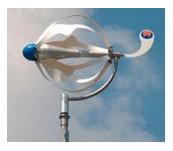 Small wind, as wind power is referred when used for residential or commercial buildings, has recently benefitted from an extension of renewable energy tax credits. This gives building owners a $1,000 or a $4,000 tax credit for residential or commercial systems, respectively.
Small wind, as wind power is referred when used for residential or commercial buildings, has recently benefitted from an extension of renewable energy tax credits. This gives building owners a $1,000 or a $4,000 tax credit for residential or commercial systems, respectively.
Small wind typically requires wind speeds to average at least 11 mph to generate a significant amount of electricity. This means that, while the Seattle metropolitan area is not an ideal candidate for wind power, some parts of Western Washington—and most of Central, Eastern and Southeastern Washington—provide excellent locations for small wind power generation.
While wind power tends to have high initial capital costs, the return on investment to the owner and the benefits to the community are many-fold. Because a great deal of the cost of wind power is in manufacturing and installation, wind power creates more primary and secondary jobs than any other source of energy per kilowatt. The high cost of solar panels, by comparison, is due to the use of expensive materials, and small wind does not require the ongoing cost of conventional fuels, such as oil, coal or natural gas.
Wind turbines provide a return on investment within 6 to 15 years, depending on wind condition. This expense can be mitigated with federal, state and local tax incentives. Further, by essentially pre-paying for electricity, one avoids the predictable increase in power costs, which occur over time. Properly maintained wind turbines will last for 20-30 years, even in very harsh climate conditions.
Wind power generators for commercial buildings are still an emerging technology. However, the continued development of small serial turbines and “wind balls”, spherical turbines that operate in very slow wind speeds, are overcoming issues that have previously been of concern for commercial use, such as noise affecting the building tenants and vibrations affecting the structural integrity of the mounting and building roof.
Wind power today costs about 20 percent of what it cost in the mid-1980s, and it is only expected to continue to decline as the market for wind power grows. Wind power is now one of the country’s largest sources of new energy, and is expected to outpace nuclear power by 2030.
